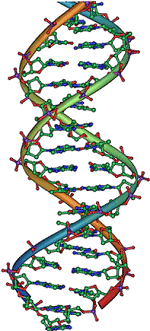Feline DNA decoded

In November 2007 a cat called Cinnamon, an Abyssinian from Missouri in the USA, became an international celebrity. This followed the anouncement that researchers have largely decoded her DNA. Dr Stephen J. O'Brien, who is at the centre of this research revealed that they had identified 20,285 of Cinnamon's genes; which is roughly 95 percent of the full feline genome. Dr O'Brien also promised that the remaining genes would be decoded in the next year or so. The feline DNA has now been added to that of about two dozen mammals with DNA which has so far been decoded. The list includes dogs, cows , monkeys, rats, mice and of course humans.
DNA contains the basic genetic instructions of how the cells in a body are constructed and organized. The existence of the famous double-helix of the DNA was one of the most important discoveries of the 20th century. The immediate reason for the interest in feline DNA is because cats have about 200 diseases which resemble human illnesses. Those include FIV (feline immunodeficiency virus) which is like human HIV, diabetes and renal diseases. Another important disease on this list is spina bifida which can affect Manx cats and which has already been mapped to the specific cat gene which is responsible for it.
This is all very well. Helping unravel the origins of some human diseases is a noble cause, but as cat lovers we have to ask - what's in it for the cat? Some vets believe that this research may indeed help the future of cat medicine. Gene therapy (replacing defective genes with properly working versions) is an expanding field and knowing the feline genetic make-up will in future help to better tailor the treatments for individual cats. A glimpse even further into the future, might reveal a time when we can manipulate the DNA of our cats and correct underlying hereditary genetic flaws before serious problems develop. This of course is still far in the future, and the outcome of this research will largely depend on the funding made available for it.
Because research in the immediate future will naturally focus on the feline diseases which have similarities to human diseases, what is discovered during this research will benefit cats as well as their humans.
How can knowing the DNA make-up of a particular species help to solve diseases? Veterinary cardiologist Dr. Frank Pipers, director of telecardiology services at VDIC explains:
"Veterinarians will be beneficiaries of research that will identify the genetic inconsistencies, and the therapies that will be developed will restore genetic harmony."
Few years ago the DNA of the dog was decoded. Already real benefits have been seen by dog breeders. The research has allowed them to work on reducing the incidence of diseases to which certain breeds of dogs have been prone, whilst understanding the canine DNA has also given researchers a invaluable insight into issues related to cancer in humans.
There was an additional spinoff from decoding the canine DNA. That is the Canine Breed Heritage Test, developed by MetaMorphix Inc. Nowadays owners can examine the genes a dog has inherited and discover what breeds went into the making of their dogs.
There will be still a few years before the real benefits of decoding of cat's DNA are seen. Meanwhile if you would like to know more about your cat's genome, the original paper which describes the decoding of feline DNA is freely available from Genome Research.
